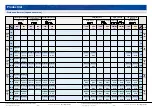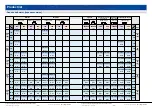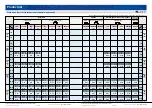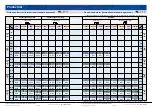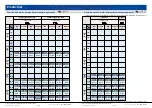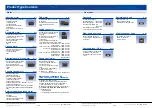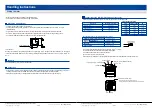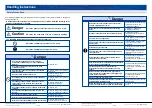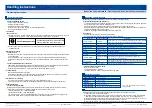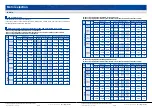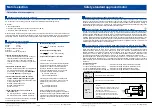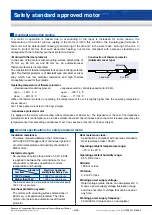
– A-34 –
Panasonic Corporation Electromechanical Control Business Division
industrial.panasonic.com/ac/e/
©
Panasonic Corporation 2018
AQCTB02E 201806-E
– A-35 –
Panasonic Corporation Electromechanical Control Business Division
industrial.panasonic.com/ac/e/
©
Panasonic Corporation 2018
AQCTB02E 201806-E
Handling instructions
Terminology
Gear reduction ratio
A ratio of the gear head with which the gear head reduces the motor speed. Panasonic offers two groups of gear
reduction ratio: one is for 3, 5, 7.5, 12.5, 15 ... and the other is 3.6, 6, 9, 15, 18 .... which are 1.2 times the
previous group so that you can obtain approx. the same output speed for both 50 and 60 Hz. When it is
necessary to fine adjust the speed smoothly use a variable speed motor and controller.
Heat generation and insulation
When a current runs through the motor, heat is generated as well. This heat generation is caused by an electrical
loss and mechanical loss. An electrical loss consists of (1) copper loss which is generated in the charged part
due to the resistance of the coil or conductor, and (2) iron loss which is generated in the iron portion of the motor
due to the resistance of the iron portion while the magnetic flux crosses them. Mechanical loss is caused by
friction loss of the bearing and brake lining.
Part of this heat generation accumulated to the motor and other is dissipated to outside of the motor through
radiation, convection and conduction. The difference between the generated heat and dissipated heat makes the
motor temperature rise, and is called heat run or temperature rise of the motor.
The hottest part on the motor is winding. Insulation used to protect the winding must be kept at a temperature
below its maximum allowable temperature. Panasonic small geared motor is provided with the heat resistance
class 120 (E) insulation when it is used in Japan, or class 130 (B) insulation when used outside Japan.
The class 120 (E) insulation will withstand temperature up to 120 ˚C.
When the heat resistance class 120 (E) insulation is used, the reduced maximum temperature limit on the motor
frame 90 ˚C, at the 40 ˚C room temperature (max. temperature specified by JIS). This motor frame temperature
will decrease to 70 ˚C at 20 ˚C room temperature. The maximum temperature limit is 50 K (deg) when measured
on the frame.
Transmission efficiency
Efficiency with which motor torque is increased by the gear head, and described in %. This efficiency is
determined by the bearing, friction of the gear tooth and resistance of lubricating oil. In general, this efficiency is
approx. 90% per stage of the gear.
For example, 81 % for 2 stage configuration, and then decreases to 75 %, 70 %, 65 % as the number of stages
increases. (In the case of metal gear head, this efficiency is approx. 85 % per stage of the gear.)
Maximum permissible torque
Maximum load torque which can be applied to the output shaft. This is determined by the mechanical strength
such as material of gear head, gear teeth and bearing and the size of gear head as well as the reduction ratio.
Service factor
Coefficient which is used to estimate the service life of the gear head.
This value is generally derived from experience and based on type of the load and operating conditions.
90 (Y)
105 (A)
120 (E)
130 (B)
155 (F)
–
60 K (deg)
75 K (deg)
80 K (deg)
100 K (deg)
• Type and temperature of insulation
Measurement of temperature rise
There are two methods to measure the temperature rise of the motor. One is to use a thermometer or
thermocouple which is fixed on the center of the motor frame. The other method determines the temperature by
measuring winding resistance as described below.
• Thermometer method
• Resistance method
Thermometer
Measure the winding resistance before and after the running, and
then determine the temperature rise from the following formula.
K
: Temperature rise at the motor winding K (deg)
R1
: Winding resistance before running
(W)
R2
: Winding resistance after running
(W)
t1
: Room temperature before running
(˚C)
t2
: Room temperature after running
(˚C)
Note: This method applies only to copper winding.
Overhung load
A vertical load applied to the output shaft of the gear head. This load is
produced when the mated machine is being connected through a chain
belt and the like but not produced if a coupling is used instead.
Maximum value of the overhung load which is applicable to the shaft is
called as “permissible overhung load”. This value varies depending on
the type of gear head and the distance from the edge of the shaft. This
value refers to the load such as belt tension.
Thrust load
An axial load applied to the output shaft of the gear head. Maximum
value of the thrust load which is applicable to the shaft is called as
“permissible thrust load”. This value varies depending on the type of the
gear head.
Gear head
Thrust load
Overhung load
Type and temperature
of insulation
Winding
temperature limit
Winding insulation material
maximum allowable temperature
K =
(
–
1
)
(235
+
t1)
+
(t1
–
t2)
R2
R1
90 ˚C
105 ˚C
120 ˚C
130 ˚C
155 ˚C
Gear head
Temperature rise of motor

